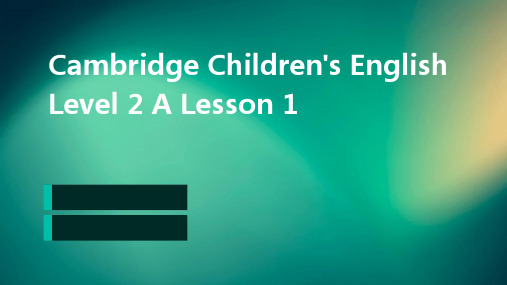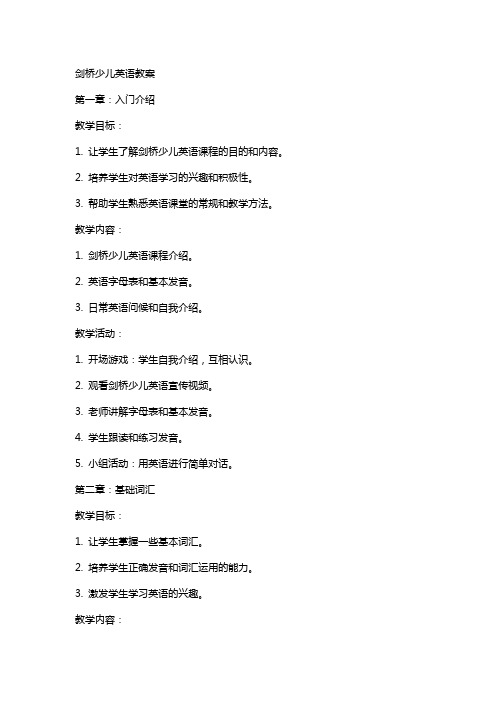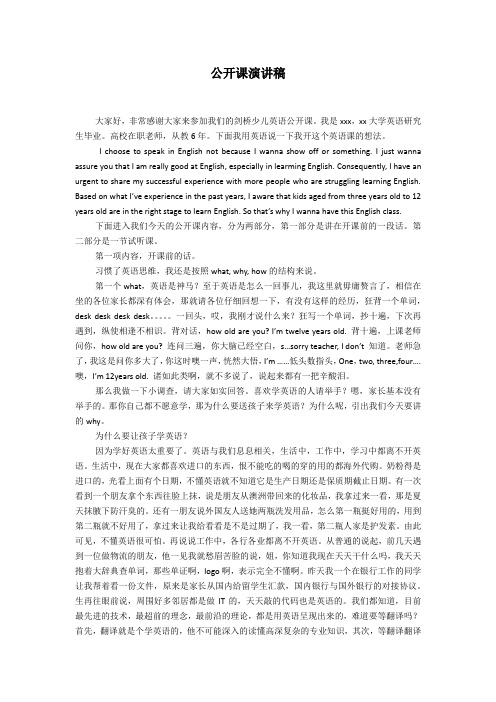剑桥儿童英语启蒙公开课
剑桥少儿英语二级A第一课

05
03
Unit 3
Listening and speaking practice through role plays and interactive activities
04
Unit 4
Reading and writing practice through creative writing and storytelling activities
The application of vocabulary and grammar
Application
Encourage students to use the new vocabulary and grammar in their daily communication, both in and outside of the classroom
Writing Practice
01 02 03
Content and Structure
The student should be able to write a coherent and well structured composition on a given topic They should provide clear introduction, body, and conclusion, with appropriate transitions between ideas
剑桥少儿英语公开课ppt课件

Intonation imitation and application
01
Rising and falling tones
Master the rising and falling tones in English sentences,
expressing different emotions and tones.
03
Enhance students' cross-cultural awareness and international perspective
04
Cultivate students' self-learning ability and collaborative spirit
Textbook content and structure
Understand the phenomena of linking, weak reading, and omission in English, and improve the naturalness of spoken language.
Sound variation rules
Learn the sound variation rules in English, such as plosives, fricatives, etc., to make pronunciation more authentic.
Ask for information sentence structures such as "What's your name?" and "How old are you?" to cultivate students' ability to communicate proactively.
剑桥国际少儿全套课件2024新版

交流。
提高学生的自主学习能力
02
引导学生养成良好的学习习惯和方法,提高自主学习能力。
培养学生的跨文化意识
03
通过了解不同国家的文化和风俗习惯,培养学生的跨文化意识
和国际视野。
教材特点与优势
丰富多彩的教材内容
教材采用生动有趣的故事、歌曲和游戏等形式,让学生在轻松愉 快的氛围中学习英语。
贴近学生生活实际的话题
比较级和最高级使用不当,如 混淆“more”和“most”的 用法。纠正方法:学习并掌握 形容词和副词比较级和最高级 的变化规则及用法,通过对比 和练习加深理解。
07 综合复习与备考建议
各部分知识点回顾与总结
听力部分
口语部分
重点复习听力技巧,如预测、听取关键信 息、理解上下文等。同时,回顾各种听力 题型,如选择题、填空题、匹配题等。
多元化的教学内容
国际化的教学标准
剑桥国际少儿英语课程体系与国际英 语教学标准接轨,注重培养学生的跨 文化交际能力。
课程内容涵盖听、说、读、写四个方 面,通过歌曲、游戏、故事等多种形 式激发学生的学习兴趣。教学目标与要求源自培养学生的英语综合运用能力
01
通过系统的课程学习,使学生能够自信、流利地运用英语进行
剑桥国际少儿全套课件
目录
• 课程介绍与背景 • 听力部分 • 口语部分 • 阅读部分 • 写作部分 • 语法与词汇部分 • 综合复习与备考建议
01 课程介绍与背景
剑桥国际少儿英语课程体系
系统化的课程设计
剑桥国际少儿英语课程体系遵循儿童 语言学习规律,采用系统化的课程设 计,逐步引导学生从基础语言知识向 高级语言技能过渡。
听力模拟试题及答案
模拟试题
提供多套模拟试题,涵盖不同主题和难度,供学生进行模拟练习。
剑桥儿童英语启蒙上册Unit通用课件

目录
CONTENTS
• Course Introduction • Teaching methods and techniques • Teaching Resources and Applications • Course evaluation and feedback • Unit teaching plan and arrangement • Teacher Role and Professional Literacy
This textbook is child-centered and adopts a fun and educational approach to help children establish an interest and foundation in English learning.
The content of the textbook covers daily life scenarios, emphasizing practicality and communication, so that children can master basic English communication skills in learning.
2 Unit division
$item1_c Including 12 thematic units, including colors, numbers, animals, food, family, school, etc., covering various aspects of life.
3
Effect: The game based teaching method can enable students to learn language in a relaxed and pleasant atmosphere, reducing learning pressure and anxiety. At the same time, game based teaching methods can also improve students' teamwork ability and competitive awareness, and cultivate their multiple intelligences.
剑桥少儿英语教案

剑桥少儿英语教案第一章:入门介绍教学目标:1. 让学生了解剑桥少儿英语课程的目的和内容。
2. 培养学生对英语学习的兴趣和积极性。
3. 帮助学生熟悉英语课堂的常规和教学方法。
教学内容:1. 剑桥少儿英语课程介绍。
2. 英语字母表和基本发音。
3. 日常英语问候和自我介绍。
教学活动:1. 开场游戏:学生自我介绍,互相认识。
2. 观看剑桥少儿英语宣传视频。
3. 老师讲解字母表和基本发音。
4. 学生跟读和练习发音。
5. 小组活动:用英语进行简单对话。
第二章:基础词汇教学目标:1. 让学生掌握一些基本词汇。
2. 培养学生正确发音和词汇运用的能力。
3. 激发学生学习英语的兴趣。
教学内容:1. 常用名词、动词和形容词。
2. 单词卡片和图片辅助教学。
3. 词汇游戏和练习。
教学活动:1. 单词卡片游戏:学生看卡片,说出单词。
2. 图片匹配:学生根据图片选择正确的单词卡片。
3. 词汇练习:学生填空或选择正确的单词。
4. 小组活动:学生用所学词汇进行简单对话。
第三章:简单句型教学目标:1. 让学生掌握简单的句型结构。
2. 培养学生能够用英语进行简单的描述和表达。
3. 提高学生的语言运用能力。
教学内容:1. 基本句型:主语+谓语+宾语。
2. 疑问句和否定句的构成。
3. 句型练习和应用。
教学活动:1. 句型结构讲解:老师用中文解释并示例。
2. 学生跟读和模仿句型。
3. 问答练习:学生互相提问并用英语回答。
4. 小组活动:学生用所学句型进行简单对话。
第四章:日常会话教学目标:1. 让学生能够进行简单的日常英语交流。
2. 培养学生运用英语进行自我表达和互动的能力。
3. 增强学生的自信心和口语表达能力。
教学内容:1. 常用日常用语和表达方式。
2. 情景对话和角色扮演。
3. 日常会话的练习和应用。
教学活动:1. 情景对话展示:老师或学生表演日常场景。
2. 学生模仿和练习对话。
3. 角色扮演:学生分组进行情景对话练习。
4. 小组活动:学生用英语进行互动交流。
剑桥少儿英语公开课ppt课件

4
Bingo
There was a farmer has a dog, And bingo was his name oh.
Bingo bingo bingo, And bingo was his name oh .
(repeat)
5
Parts of our body
6
7
8
9
10
11
1
基本概述
• 剑桥少儿英语是英国剑桥大学考试委员会 针对非英语母语国家6至12岁少年儿童的英 语能力培养和提高设计的考试。在中国, 它是家长提升孩子英语能力与成绩的第一 选择。
• 从培养少年儿童的英语基础语言能力和语 感入手,培养学生的英语语言思维能力, 建立起英语学习的自信心与荣誉感的学习 系统。
2
教材特色
• 极易调动孩子的学习兴趣和积极性。视听 结合:形象活泼的动画、标准地道的语音 、朗朗上口的儿歌、配以动听的音乐,让 孩子在提供了清晰的辅导步骤、教学内 容、教学目标、 对话练习、英语游戏、学 习评估,便于家长辅导、督促孩子学习英 语。
12
13
14
15
16
Game(游戏)
17
touch
18
• 游戏分两组进行,组内有人做错减1分,全 体做对加1分,有一人没做对不加分,分数 高的小组获胜。
• 当老师说Simon says,并且说出五官中的 一个的时候,迅速指向老师说出的单词的 部位。
• 老师没有说Simon says,但是却指向了自 己的五官的同学所在的组减一分。
19
Sum up:今天你们学会了什么?
20
Homework: 1、给家长唱apple tree儿歌 2、边指器官,边说 英文单词给家长听。
公开课演讲稿

公开课演讲稿大家好,非常感谢大家来参加我们的剑桥少儿英语公开课。
我是xxx,xx大学英语研究生毕业。
高校在职老师,从教6年。
下面我用英语说一下我开这个英语课的想法。
I choose to speak in English not because Iwannashow off or something. I just wanna assure you that I am really good at English, especially in learming English. Consequently, I have an urgent to share my successful experience with more people who are struggling learning English. Based on what I’ve experience in the past years, Iaware that kids aged from three years old to 12 years old are in the right stage to learn English. So that’s why Iwanna have this English class.下面进入我们今天的公开课内容,分为两部分,第一部分是讲在开课前的一段话。
第二部分是一节试听课。
第一项内容,开课前的话。
习惯了英语思维,我还是按照what, why, how的结构来说。
第一个what,英语是神马?至于英语是怎么一回事儿,我这里就毋庸赘言了,相信在坐的各位家长都深有体会,那就请各位仔细回想一下,有没有这样的经历,狂背一个单词,desk deskdeskdesk。
一回头,哎,我刚才说什么来?狂写一个单词,抄十遍,下次再遇到,纵使相逢不相识。
背对话,how old are you? I’m twelve years old. 背十遍,上课老师问你,how old are you? 连问三遍,你大脑已经空白,s…sorry teacher, I don’t 知道。
剑桥国际少儿英语全套课件(ppt)

剑桥国际少儿英语
(第3册)
Lesson 3, Unit 1
Warmer
• Game: Hug, Hug!
Presentation
Yes or No?
Practice
• Stella doesn’t want to be a doctor. • Suzy wants to bath her doll. • Dotty likes having baths.
• sock, six, hand, leg
Presentation
• Say it with Stella.
Production • Let’s make a survey.
Goodbye
剑桥国际少儿英语
(第3册) Lesson 6, Hello Unit
Mary
Warmer
Animal guessing game
Production
My own family tree.
She’s my aunts daughter.
剑桥国际少儿英语
(第3册)
Lesson 2, Unit 1
Warmer
• learning English • painting a picture • playing football • reading a book
playing basketball wearing a hat
eating hamburgers drinking milk
Production
• Show and tell
剑桥国际少儿英语
(第3册)
Lesson 6, Unit 1
Warmer
• Please help me! • Please find Clarence! • Get the Detective Box.
